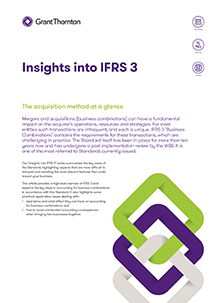
This article provides a high-level overview of IFRS 3 and explains the key steps in accounting for business combinations in accordance with this Standard. It also highlights some practical application issues dealing with:
- deal terms and what effect they can have on accounting for business combinations
- how to avoid unintended accounting consequences when bringing two businesses together.
Our ‘Insights into IFRS 3’ series summarises the key areas of the Standard. Download the full article or read on for a high-level overview of IFRS 3.

The acquisition method
IFRS 3 establishes the accounting and reporting requirements (known as ‘the acquisition method’) for the acquirer in a business combination. The key steps in applying the acquisition method are summarised below:
Effect of deal terms on the accounting for business combinations
The terms and structures of sales and purchase agreements vary extensively, and they will determine how a business combination should be accounted for. It is important that management is aware of the financial reporting consequences of putting in place certain terms and conditions into sale and purchase agreements. The following summarises some common deal terms and their related effects on the financial reporting for business combinations.
Reporting business combinations and avoiding surprises
Reporting a business combination is a significant exercise. A considerable amount of time and effort usually needs to be put into gathering, assembling and evaluating all the information required to be reported in the financial statements under IFRS 3. Presented below are some planning considerations and suggestions on how they can be implemented.
We hope you find the information in this article helpful in giving you some insight into IFRS 3. If you would like to discuss any of the points raised, please speak to our experts Christoph Zimmel and Rita Gugl.


